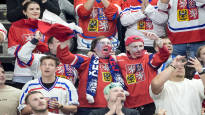The opening of the World Cup showed what hockey culture means. At the same time, it forced us to ask how far Leijonat is from the top countries in the tournament, writes Jussi Paasi.
Jussi Paasi sports reporter
PRAGUE.
17,000 passionate pool fans. Infernal atmosphere.
The party started well before the start of the match itself. The crowd’s screams were deafening as the home team’s fans opened their vocal chords. There were still three quarters until the start of the game.
The Czech Republic is a hockey nation.
However, the mood sometimes spilled over in the upper galleries, when the fans of the home team started crowding into the arena’s media stand. Despite repeated warnings from the organizers, they remained seated in the seats reserved for journalists.
I’ve never seen anything like that before. That’s when I tapped on this thing, while a group was sitting next to me, passing beer and shouting and whistling loudly.
When the puck hit the ice, the decibels rose to wild numbers. I haven’t experienced something like this in almost a decade, although in my work I have been able to see the World Cup and other ice hockey matches on site in abundance.
The last time I witnessed this kind of abuse was in this same Prague Arena in 2015, when the Czech Republic knocked out the Lions in the quarter-final match of the World Cup.
While listening to the shocking storm of screams, I also went back in my mind to the events of last spring and the one before that.
The World Ice Hockey Championships were played in 2022 and 2023 in Tampere. In Manse, the games were advertised as the “capital of ice hockey”, or was it “the home of ice hockey”, with the slogan.
It was quiet at home. In the last games, downright dreamy. The atmosphere was non-existent, if you compare it to this crazy mood in the Czech Republic. In Finland, corporate guests occupied a large part of the arena. And in the audience it was according to it.
The Prague Arena doesn’t have that famous shrimp maze. This is how the home of hockey should sound and look. Of course, without fans invading the media stands.
The motto of the Czech World Cup is heart of the game. Everyone who was there really had their hearts pounding.
The opening game raised a big question
On the ice, the level difference between the teams seemed to be almost as big as in the atmosphere of the World Cup in Tampere and Prague.
The host country controlled the game events however it wanted. Finland was a complete opponent when the Czech Republic collapsed Harri Säterin to the goal. In the first period, Leijonat managed one shot towards the Czech goal. In the second set, the same rally continued.
Even before the games, it was clear that Leijonat is not one of the tournament’s favorites this time. Canada, USA and Sweden are on the move with teams boasting NHL stars. The Czech Republic does not have quite the same level of stardom in its group, so the level difference should not have been so great compared to Finland.
But the difference was even huge for two sets.
I don’t remember why Leijonat would have been so unarmed against an opponent during Jalonen’s season. Finland was not able to challenge the Czech Republic in any area – with the exception of goalkeeping.
In the third period, however, Finland got the hang of the plot and even managed to create good scoring opportunities. In overtime, Leijon was forced to win, but even from good positions with the advantage, the puck didn’t sink into the net.
Overtime was puck entertainment with a big V. Solkena’s scoring opportunities at both ends. In the end, the solution was sought in the winning goal competition. In that, Säteri had to surrender twice.
Despite the loss and the wretchedness of the two sets, no major crisis should be declared for the Lions yet. It is good to remember that in this tournament one match will decide. Semi-final. Before that, almost anything can happen.
And in that one game, as this match showed, almost anything can happen.
However, the opening game raised a big question. How big is Finland’s level difference compared to the toughest top countries in the tournament, i.e. Canada, Sweden and the USA?
